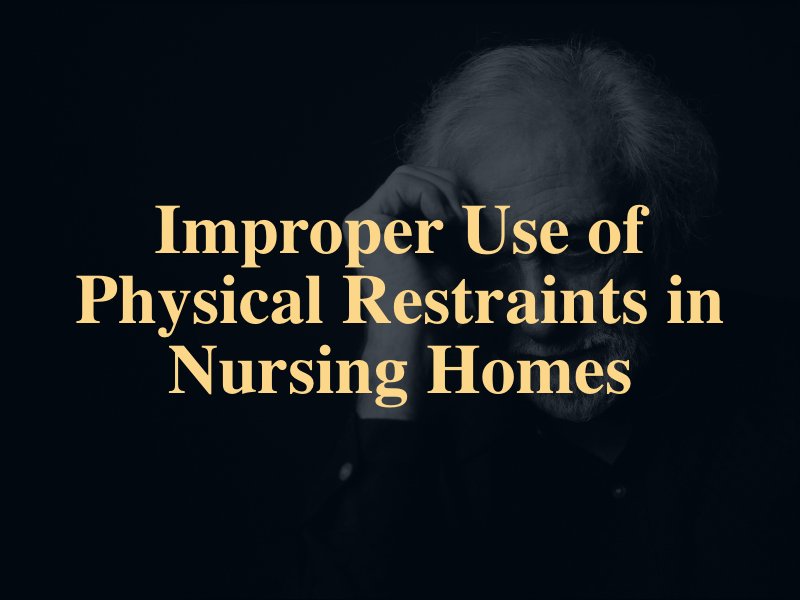
No recovery no fee
When loved ones place an elderly family member into a nursing home, it’s typically because their care needs exceed the capabilities of a home environment. Most family members carefully research to find the best possible long-term care within their budget for their loved ones. They expect the caregivers and staff members to treat an elderly family member with the dignity and respect they’ve earned over a lifetime. Sadly, some nursing homes do not live up to this expectation. One common form of nursing home abuse is the improper use of physical restraints. Improperly using physical restraints is a violation of human rights. Contact the Phoenix nursing home abuse lawyers at Knapp & Roberts for a free consultation.

Physical restraints are equipment or devices used to restrict a patient or nursing home resident’s physical movement. Some physical restraint use is necessary in a nursing home. For instance, bed rails are a form of physical restraint meant to prevent a fall, but bed rails kept in a high position can restrict an elderly resident to a bed because they are unable to lower the rails to rise from the bed. Some restraint use restricts the resident’s ability to move in a manner that’s detrimental to the resident’s physical and emotional health. Common physical restraints used in nursing homes include the following:
Lap cushions and lap tables are also sometimes used to restrict a nursing home resident’s movements or ability to rise. Another common practice is to tilt a resident’s chair upward against a wall so the angle leaves the resident unable to rise from the chair.
Under the Nursing Home Reform Laws, nursing homes may only use physical restraints during treatment for a medical condition, to ensure the resident’s physical safety, or to protect caregivers from a violently agitated resident. The law prohibits nursing homes from using restraints to punish a resident or for disciplinary purposes. They also may not use physical restraints for the staff’s convenience; for instance, using restraints in place of patient monitoring due to staffing shortages.
Individual states may have additional requirements for restraint use. Florida requires a doctor’s authorization for using restraints on a nursing home resident and specified limits to the amount of time the resident is restrained.
Some states require a doctor’s order for restraint use, but all states require consent for the use of restraints. A doctor or provider must recommend restraints for a legally allowable reason such as patient or staff safety, and then obtain consent from the resident or their legal guardian or representative—this is far more common since cognitively impaired individuals cannot give legal consent and wouldn’t typically consent to their own restraining.
If a nursing home requests consent to restrain an elderly loved one, you have a right to decline their use and ask for alternatives such as a safer room environment and increased monitoring rather than restraining. Although nursing homes may approach family members by warning of fall risk for an unrestrained patient, it’s important to note that restraining a patient causes worsened balance and coordination, making a fall more likely in the long run.
Since the Nursing Home Reform Laws, the U.S. has had the lowest number of restrained nursing home residents at just under two percent. Spain and Singapore have the highest numbers at over 84.9 percent, and 98 percent respectively of residents restrained. The most commonly named reasons for restraint use include the following:
The use of physical restraints can have life-altering consequences for elderly nursing home residents.
Limiting an individual’s movement has serious impacts, especially on vulnerable elderly individuals with weakened immunity, other health problems, and declining cognitive abilities. By restraining a nursing home resident, it increases the chances of the following health problems:
In addition, a restrained nursing home resident is at risk of asphyxiation, increased problems with balance and coordination, cognitive decline, and an increased reliance on caregivers. Restraint use also causes significant psychological distress. Being restrained, kept immobile, and unable to move freely is humiliating and discouraging for elderly residents and increases depression and despair which may cause increased cognitive decline.
Many federal and state laws restrict the use of restraints in nursing homes, yet restraint use continues to be a problem. Some nursing homes have made proactive efforts to limit restraint use or to become restraint-free facilities. There are many viable alternatives to nursing home restraints, including the following:
Studies show that restraint-free facilities are possible with increased supervision and more individual-centered care plans. Restraint-free facilities have better overall outcomes for residents’ physical and emotional health.
When a nursing home uses restraints for non-medical purposes or for safety, or if they use restraints without consent from the patient or their guardian, it’s a form of abuse because it’s using restraints outside of the legally allowable reasons. If a nursing home resident suffers injuries from the restraints or suffers a significant physical or cognitive decline due to the use of restraints, the nursing home is liable for damages, including medical costs, compensation for pain and suffering, and sometimes for wrongful death. If a loved one has been injured by improper usage of restraints, contact a Phoenix nursing home abuse lawyer to start your case today.
The personal injury attorneys in Phoenix, Arizona, at Knapp & Roberts have the compassion and trial lawyer skills to tell your story to a jury. We will get to know you and your family so that we can help the jury understand what has happened to you and your family and how it has changed your lives. Obtain the compensation necessary for the injuries and losses you have suffered.